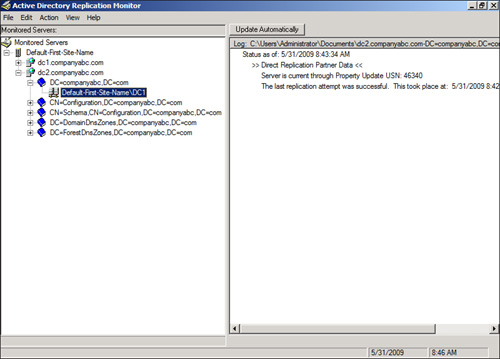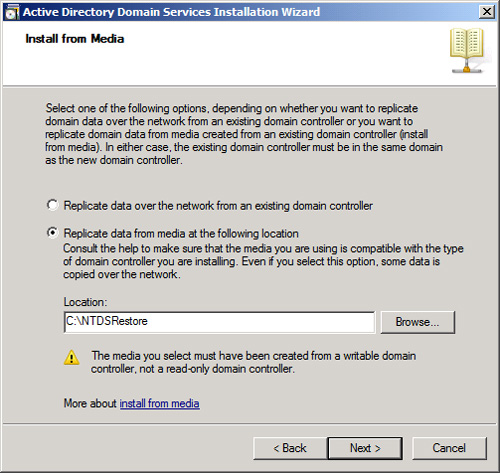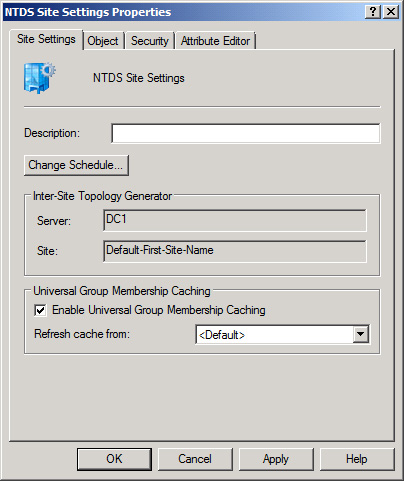Verifying Global Catalog Creation
When a domain
controller receives the orders to become a global catalog server, there
is a period of time when the GC information replicates to that domain
controller. Depending on the size of the global catalog, this could take
a significant period of time. To determine when a domain controller has
received the full subset of information, use the replmon (replication monitor) utility from the Windows Server 2003 support tools. The replmon
utility indicates which portions of the AD database are replicated to
different domain controllers in a forest and how recently they have been
updated.
Note
Unfortunately, the replmon
tool did not survive the transition from Windows Server 2003 to Windows
Server 2008. It is not included in the tools shipped with Windows
Server 2008. However, the Windows Server 2003 Support Tools can be
installed on a Windows Server 2008 domain controller to gain access to
the tool. The compatibility warning can be safely ignored.
Replmon
enables an administrator to determine the replication status of each
domain-naming context in the forest. Because a global catalog server
should have a copy of each domain-naming context in the forest,
determine the replication status of the new GC with replmon. For example, the fully replicated global catalog server in Figure 2
contains the default naming contexts, such as Schema, Configuration,
and DnsZones, in addition to domain-naming contexts for all domains. In
this example, the companyabc.com domain has been replicated successfully to the DC2 domain controller.

Global Catalog and Outlook in Exchange Server 2010
In Exchange Server
2003 and Exchange Server 2007, Outlook clients would make direct calls
to global catalog servers. This made them susceptible to failure or
demotion of domain controllers with global catalogs. In many cases, the
failure of a global catalog server would require the restart of all
Outlook clients that were using it for lookups.
In Exchange Server
2010, the Outlook client access to the directory has been changed.
Outlook clients communicate with the RPC Client Access Service on a CAS.
This service proxies the global catalog lookups for the Outlook clients
rather than having them query the global catalog directly. This reduces
the direct dependency of Outlook clients on the global catalog,
allowing for better scalability and faster recovery if a global catalog
failure occurs.
Deploying Domain Controllers Using the Install from Media Option
When
deploying a remote site infrastructure to support Exchange Server 2010,
take care to examine best-practice deployment techniques for domain
controllers to optimize the procedure. In the past, deploying domain
controller and/or global catalog servers to remote sites was a rather
strenuous affair. Because each new domain controller would need to
replicate a local copy of the Active Directory for itself, careful
consideration into replication bandwidth was taken into account. In many
cases, this required one of these options:
The domain controller was set up remotely at the start of a weekend or other period of low bandwidth.
The
domain controller hardware was physically set up in the home office of
an organization and then shipped to the remote location.
This procedure was
unwieldy and time-consuming with Windows 2000 Active Directory.
Fortunately, Windows Server 2003 and Windows Server 2008 addressed this
issue through use of the Install from Media option for Active Directory
domain controllers.
The concept
behind the media-based GC/DC replication is straightforward. A current,
running domain controller backs up the directory through a normal backup
process. The backup files are then copied to a backup media, such as a
CD or tape, and shipped to the remote GC destination. Upon arrival, the dcpromo command can be run with the /adv switch (dcpromo /adv), which activates the advanced options including to install from media, as illustrated in Figure 3.

After the dcpromo
command restores the directory information from the backup, an
incremental update of the changes made since the media was created is
performed. Because of this, you still need network connectivity
throughout the dcpromo process, although the amount of replication required is significantly less. Because some dcpromo
operations in very large organizations have been known to take days and
even weeks, this concept can dramatically help deploy remote domain
controllers.
Note
If the copy of the global
catalog that has been backed up is older than the tombstone date for
objects in the Active Directory (which by default is 60 days), this type
of dcpromo will fail. This
built-in safety mechanism prevents the introduction of lingering objects
and also assures that the information is relatively up to date and no
significant incremental replication is required.
Understanding Universal Group Caching for AD Sites
Windows Server 2008
Active Directory enables the creation of AD sites that cache universal
group membership. Any time a user uses a universal group, the membership
of that group is cached on the local domain controller and is used when
the next request comes for that group’s membership. This also lessens
the replication traffic that would occur if a global catalog was placed
in remote sites.
One of the main sources
of replication traffic is group membership queries. In Windows 2000
Server Active Directory, every time clients logged on, their universal
group membership was queried, requiring a global catalog to be
contacted. This significantly increased logon and query time for clients
who did not have local global catalog servers. Consequently, many
organizations had stipulated that every site, no matter the size, have a
local global catalog server to ensure quick authentication and
directory lookups. The downside of this was that replication across the
directory was increased because every site would receive a copy of every
item in the entire AD, even though only a small portion of those items
would be referenced by an average site.
Universal group
caching solved this problem because only those groups that are commonly
referenced by a site are stored locally, and requests for group
replication are limited to the items in the cache. This helps limit
replication and keep domain logons speedy.
Universal group caching capability is established on a per-site basis, through the following technique:
1. | On
the domain controller, open Server Manager and expand Roles, Active
Directory Domain Services, and then click Active Directory Sites and
Service.
|
2. | Navigate to Sites, sitename.
|
3. | Right-click NTDS Site Settings, and choose Properties.
|
4. | Check the Enable Universal Group Membership Caching check box, as shown in Figure 4.

|
5. | Click OK to save the changes.
|
Note
Universal
group (UG) caching is useful for minimizing remote-site replication
traffic and optimizing user logons. Universal group caching does not
replace the need for local global catalog servers in sites with Exchange
servers, however, because it does not replace the use of the GC port
(3268), which is required by Exchange Server. UG caching can still be
used in remote sites without Exchange servers that use the site
consolidation strategies of Exchange Server previously mentioned.